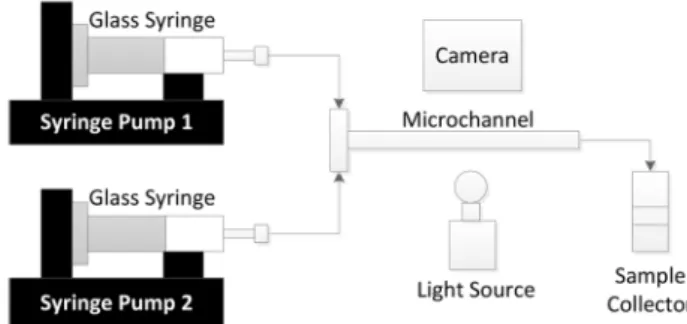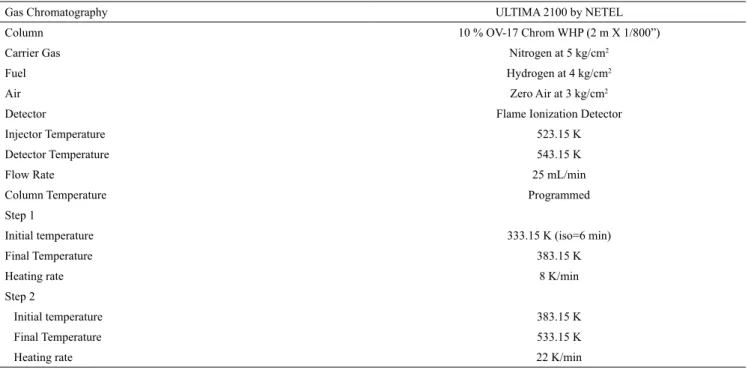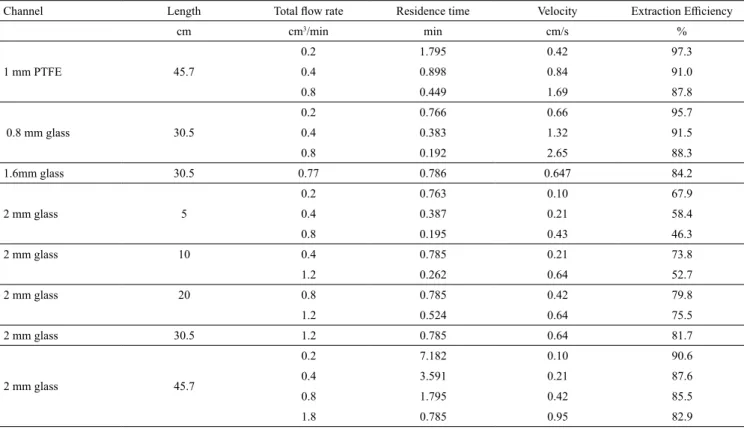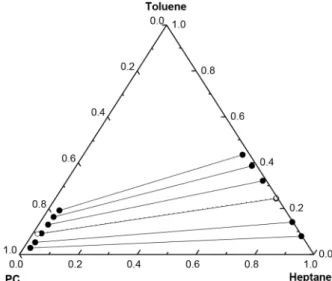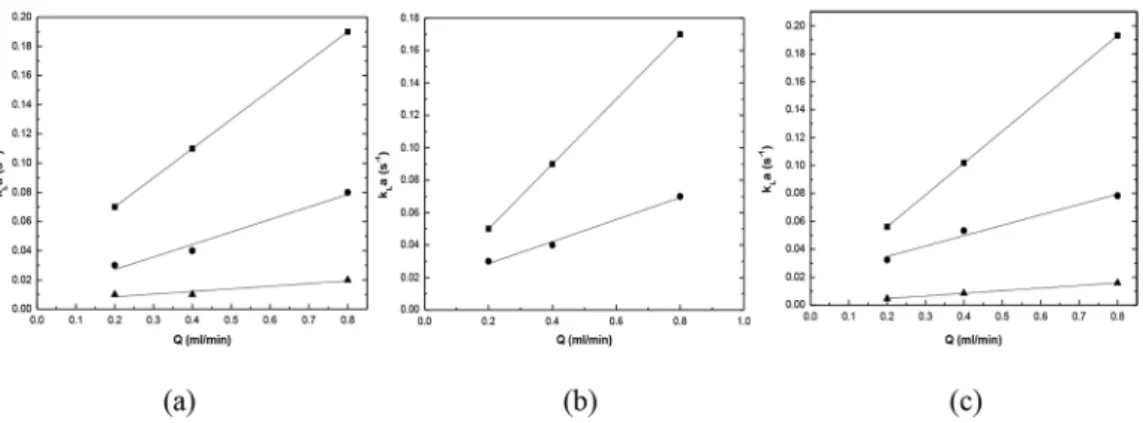of Chemical
Engineering
ISSN 0104-6632 Printed in Brazil www.scielo.br/bjce
Vol. 35, No. 02, pp. 605 - 614, April - June, 2018 dx.doi.org/10.1590/0104-6632.20180352s20160654
LIQUID-LIQUID EXTRACTION OF AROMATICS
FROM HYDROCARBON MIXTURES IN
CAPILLARIES
U. K. Arun Kumar
1* and Ratan Mohan
21 Department of Chemical Engineering, Malaviya National Institute of Technology
Jaipur, J. L. N. Marg, Jaipur, Rajasthan-302017, India, Tel : +91-141-271-3513; Mobile: +91-9549654174, E-mail address: ukakumar.chem@mnit.ac.in 2 Department of Chemical Engineering, Indian Institute of Technology Delhi, Hauz
Khas, New Delhi, Delhi 110016, India. Tel: +91-11-2659- 1033; Email: ratan@iitd.ac.in
(Submitted: November 22, 2016; Revised: May 17, 2017; Accepted: May 31, 2017)
Abstract - An aromatics extraction study was conducted in capillaries of internal diameters in the range of 0.8 mm to 2 mm. The systems chosen for study were ‘n-heptane + toluene + propylene carbonate’, ‘n-heptane + toluene + furfural’ and ‘synthetic naphtha reformate + (propylene carbonate + tetraethylene glycol)’. The aim of the work was to evaluate the feasibility of conducting aromatic separation in micro-capillaries and evaluate maximum efficiency. The results showed efficiencies ranging from 46.3 % to 97.3 %, depending upon the combination of the flow velocity, residence time and channel diameter. The effect of individual parameters on extraction efficiency was also isolated from the various combinations. Efficiency increased from 68 to 83 % as flow velocity increased from 0.11 to 0.96 cm/s, while residence time and channel diameter were fixed at 0.78 min and 2 mm, respectively. The samples collected from the capillary quickly separated into clear liquid layers , indicating short settling times.
Keywords:aromatics separation, liquid-liquid extraction, micro-/milli-capillaries.
INTRODUCTION
Separation of aromatics from petroleum mixtures such as naphtha reformate, lube oils is part of petroleum refining and is done by liquid-liquid extraction in contactors like mixer-settler, sieve plate column, etc. Of late, the use of micro-channels for extraction is also being studied in view of process intensification possibilities. The small diameters of the channels provide high specific surface area in the range of 10,000 - 50,000 m2/m3, whereas the
maximum surface area to volume ratio in stirred vessels is of the order of 1000 m2/m3 (Jovanovic et al.,
2011; Antony et al., 2014). Other important advantage
of using micro-channels is in mixing, where short diffusion distances enhance mass transfer (Su et al., 2010). Further, micro-channel contacting provides better control and does not involve any mechanical moving parts for mixing. Various liquid-liquid flow patterns can be generated in micro-channels, namely: (a) drop flow, (b) slug flow (c) slug drop flow (d) deformed interface flow (e) annular and parallel flow (f) slug-dispersed flow and (g) dispersed flow (Kashid et al., 2011). But the most widely studied flow patterns for mass transfer applications are slug flow, drop flow and parallel flow. Amongst them, slug flow and emulsion flow are found to be more efficient for mass transfer. However, slug flow is more advantageous
than emulsion flow in terms of handling and settling time (Okubo et al., 2008; Kamio et al., 2011). Though several extraction studies involving two immiscible liquids in microchannels are seen in the literature, work related to aromatics extraction is reported here.
Burns and Ramshaw (2001) studied the extraction of acetic acid from kerosene using water as the solvent in a glass-chip channel employing the slug flow method. They obtained an extraction efficiency of 97 %. Kashid et al. (2007) carried out liquid-liquid extraction studies for three non-reactive systems using slug flow in microchannels. The three systems were ‘water + iodine + kerosene’, ‘kerosene + acetic acid + water’ and ‘water + succinic acid + n-butanol’. Solutes were iodine, acetic acid and succinic acid, respectively. Extraction efficiencies of 90 % were achieved for all the systems. Zhao et al. (2007) have reported extraction studies for the system ‘water + succinic acid + n-butanol’ in rectangular stainless steel microchannels with a T-junction and found that the mass transfer coefficient was three to four times higher than in the conventional contactors. Okubo et al. (2008) carried out extraction studies in microchannels employing three flow regimes, stratified, slug and emulsion flow, to extract phenol from dodecane using water as the solvent. They found that, for high throughput operations, the slug flow method of extraction was more suitable than the other two methods. Kamio et al. (2011) studied the separation of the ethyl ester of docosahexanoic acid (DHA-Et) with silver ions using slug flow and water-in-oil (W/O) emulsion methods. They too found that slug flow was more advantageous for easy handling and rapid extraction than the emulsion method. More recent studies on mass transfer and extraction in liquid-liquid slug flow in micro and small scale channels have been made by Assmann et al. (2011), Xu et al. (2013), Liu et al. (2014), Tsaoulidis and Angeli (2015).
In summary, though several studies of extraction in microchannels have been reported earlier, work on aromatic separation from hydrocarbon mixtures is not seen. Hence in the present work, solvent extraction of aromatics from hydrocarbon mixtures in microchannels is studied. The solvents employed were furfural, and a mix of propylene carbonate (PC) and tetra-ethylene glycol (TTEG), i.e., from the green solvents category. Two ternary systems, ‘n-heptane+toluene+PC’ and ‘n-heptane+toluene+furfural’, and one ten-component ‘synthetic naphtha reformate+PC+TTEG’ were studied. Studies were conducted in micro-/ millichannels, actually capillaries, for three ‘alkane + aromatic + solvent systems. The capillaries were of internal diameters (i.d.) from 0.8 mm to 2 mm and
of varying lengths. Experiments were conducted for different flow rates and residence times. Effects of velocity, residence time and diameter on extraction efficiency were studied.
EXPERIMENTAL METHODS
Materials
Experiments were carried out in glass capillaries of i.d. 0.8 mm, 1.6 mm and 2 mm. A Teflon i.e., polytetrafluoro ethylene (PTFE) capillary tubing of 1 mm i.d. was also used. The capillary lengths were in the range 5 cm to 45.7 cm. Two syringe pumps (Harvard Apparatus) with an accuracy of ± 0.5 % were employed for pumping the liquids through the capillaries.
The chemicals used in the study were n-heptane, toluene and cyclohexane (supplied by Qualigens, India) and benzene (supplied by Ranbaxy Fine Chemicals, India). All were HPLC grade materials. Furfural was supplied by CDH Laboratories, India. Dodecane and ethylbenzene were supplied by Spectrochem, India. o-Xylene was supplied by Loba Chemie, India. Propylene carbonate and tetra-ethylene glycol were from Sigma-Aldrich. The purities of all these chemicals were rated to be > 99 % by the manufacturers. The materials were used as supplied by the manufacturers, without any further purification.
Procedure
Figure 1. Schematic diagram of the microchannel extraction set-up.
RESULTS AND DISCUSSION
As stated earlier, the aim was to determine the effectiveness of using micro-channels or capillaries for aromatics extraction. For this, extraction efficiency has been taken as the measure and its variation with parameters like flow velocities, capillary diameter, residence time, have been studied. Subsequently, volumetric mass transfer coefficients were also estimated. The systems studied are ‘n-heptane + toluene + propylene carbonate’, ‘n-heptane + toluene + furfural’ and ‘synthetic naphtha reformate + (propylene carbonate + tetraethylene glycol)’. Flow rates and capillary dimensions are given in Table 3. The values were chosen such that effects of individual parameters like flow velocity, residence time, can also be isolated.
Extraction efficiency
Extraction efficiency is defined and calculated from Eqn. (1) (Zhao et al., 2007; Tang et al., 2013):
(1)
In the equation, C2,in and C2,out represent the inlet and the outlet concentration of the solute (toluene for the ternary system and total aromatics in synthetic naphtha reformate) in the solvent respectively. C2,sat
is the equilibrium concentration of the solute in the extract phase. E, is defined as the transported solute to the maximum transferable solute.
2-3 times to confirm the reproducibility of results. The conditions maintained in gas chromatography are given in Table 1 for the ternary systems and in Table 2 for the synthetic naphtha reformate system. For the ten component synthetic naphtha reformate system, most of the parameters were the same, except the injector and detector temperatures, which were lower by 25 K, and the column final temperature, which was higher by 35 K.
n-Heptane + Toluene + Propylene Carbonate at 25 ºC
The extraction efficiency results for the system ‘n-heptane + toluene + propylene carbonate’ at 25ºC are given in Table 4. The table also gives the total volumetric flow rates and the corresponding residence times and velocities of the system. LLE data for this system were directly used from the report published by Salem (1993). Comparison of extract phase compositions with LLE tie line data is shown in Figure 2 for a 1 mm PTFE channel and 0.2 mL/min flow rate. It can be seen that, for this case, the separation obtained in micro-channel extraction is almost the same as equilibrium separation. An extraction efficiency plot for the system in Figure 3 shows its variation with flow rate.
For a total volumetric flow rate of 0.2 mL/min in a PTFE channel of 1 mm i.d. and 45 cm in length, an extraction efficiency of 97.3 % was achieved in 1.79 min contact time. The high extraction efficiency is attributed to very good mass transfer between the slugs, due to the internal circulations that arise within them. As the flow rate is increased, the shearing of slugs also increases, leading to enhanced internal circulation. However, it was seen that at a flow rate of 0.8 mL/min, the extraction efficiency is lower, 87.8 %. This is because, although the velocity, v , is four times higher (1.69 cm/s), the residence time, τ, is now four times less at 0.45 min. While the higher flow increases the internal circulations, it also decreases the contact time and reduces the extraction achieved. Thus, it is seen in Figure 3 that, while E generally decreases with flow rate Q, this is the result of two opposing factors. Therefore, the particular combinations were taken from Table 4, which allow the effect of a single parameter to be isolated. This is discussed in the following.
Effect of individual parameters
The effect of flow velocity on extraction efficiency, keeping the diameter and the residence time constant, is shown in Figure 4(a). The channel diameter was 2 mm and the residence time was kept at ~ 0.78 min by having channels of different lengths. Flow rates were varied from 0.2 to 1.8 mL/min, i.e., velocities of 0.109 to 0.955 cm/s. It is seen that the extraction efficiency increases from 67.9 to 82.9 % as the velocity increases, i.e., now only this is the cause of improved internal circulation and mixing.
Likewise, the effect of residence time on extraction efficiency is shown in Figure 4(b). Residence time was changed by adjusting the capillary lengths and the flow rates. Here, the diameter of the channel and
E
C
C
C
C
, ,
, ,
sat in out in
2 2
2 2
=
-Table 1. GC parameters for the ternary systems.
Gas Chromatography ULTIMA 2100 by NETEL
Column 10 % OV-17 Chrom WHP (2 m X 1/800”)
Carrier Gas Nitrogen at 5 kg/cm2
Fuel Hydrogen at 4 kg/cm2
Air Zero Air at 3 kg/cm2
Detector Flame Ionization Detector
Detector Temperature 568.15 K
Injector Temperature 548.15 K
Flow Rate 23 mL/min
Column Temperature Programmed
Initial temperature 333.15 K (iso=1 min)
Final Temperature 498.15 K
Heating rate 20 K/min
Table 2. GC parameters for the ‘synthetic naphtha reformate +PC +TTEG’ system.
Gas Chromatography ULTIMA 2100 by NETEL
Column 10 % OV-17 Chrom WHP (2 m X 1/800”)
Carrier Gas Nitrogen at 5 kg/cm2
Fuel Hydrogen at 4 kg/cm2
Air Zero Air at 3 kg/cm2
Detector Flame Ionization Detector
Injector Temperature 523.15 K
Detector Temperature 543.15 K
Flow Rate 25 mL/min
Column Temperature Programmed
Step 1
Initial temperature 333.15 K (iso=6 min)
Final Temperature 383.15 K
Heating rate 8 K/min
Step 2
Initial temperature 383.15 K
Final Temperature 533.15 K
Heating rate 22 K/min
the velocity of the fluids are held constant. For the diameter (i.d.) of 2 mm and velocity fixed at 0.64 cm/s, it was found that the extraction efficiency increased from 52.7 to 81.7 %, corresponding to a residence time increase from 0.26 to 0.78 min.
Finally the effect of varying the diameter of the channel on extraction efficiency was also found. The results shown in Figure 4(c) have a residence time of ~ 0.78 min and the velocity fixed at 0.65 cm/s. Extraction efficiency decreased with the increase in diameter, from 95.7 to 81.7 %.
n-Heptane+Toluene+Furfural and Synthetic Naph-tha Reformate+(PC+TTEG) at 30 ºC
In these two systems studied, toluene was extracted by the solvent furfural in the first case. In the second,
Table 3. Capillary dimensions and flowrates employed in the experiments.
Channel Length Area Volume Total flow rate Residence time
(i.d.) cm cm2 cm3 cm3/min min
1 mm PTFE 45.7 0.00785 0.3591
0.2 1.795
0.4 0.898
0.8 0.449
0.8 mm glass 30.5 0.00502 0.1532 0.2 0.766
0.4 0.383
0.8 0.192
1.6 mm glass 30.5 0.03142 0.6132 0.77 0.786
2 mm glass 5 0.03142 0.1571 0.2 0.763
0.4 0.387
0.8 0.195
2 mm glass 10 0.03142 0.3142 0.4 0.785
1.2 0.262
2 mm glass 20 0.03142 0.6283 0.8 0.785
1.2 0.524
2 mm glass 30.5 0.03142 0.9582 1.2 0.785
2 mm glass 45.7 0.03142 1.4363 0.2 7.182
0.4 3.591
0.8 1.795
Table 4. Extraction efficiency results for the system n-Heptane + Toluene + Propylene Carbonate at 25 °C.
Channel Length Total flow rate Residence time Velocity Extraction Efficiency
cm cm3/min min cm/s %
1 mm PTFE 45.7
0.2 1.795 0.42 97.3
0.4 0.898 0.84 91.0
0.8 0.449 1.69 87.8
0.8 mm glass 30.5
0.2 0.766 0.66 95.7
0.4 0.383 1.32 91.5
0.8 0.192 2.65 88.3
1.6mm glass 30.5 0.77 0.786 0.647 84.2
2 mm glass 5
0.2 0.763 0.10 67.9
0.4 0.387 0.21 58.4
0.8 0.195 0.43 46.3
2 mm glass 10 0.4 0.785 0.21 73.8
1.2 0.262 0.64 52.7
2 mm glass 20 0.8 0.785 0.42 79.8
1.2 0.524 0.64 75.5
2 mm glass 30.5 1.2 0.785 0.64 81.7
2 mm glass 45.7
0.2 7.182 0.10 90.6
0.4 3.591 0.21 87.6
0.8 1.795 0.42 85.5
Figure 2. Comparison of equilibrium and extraction data for the system
"n-heptane (1) + toluene (2) + PC (3)" at 298.15 K; (●) LLE, Salem et al. (1993), (○) 1 mm PTFE channel, flow rate 0.2ml/min.
Figure 3. Extraction efficiency, E, for the system 'n-heptane + toluene + PC' at 298.15 K; (●) 1 mm channel-45 cm, (■) 0.8 mm channel-30 cm, (▲) 2 mm channel-45 cm, (○) 2 mm channel-5 cm. Q, is the total volumetric flow rate.
Figure 4. Results for the system 'n-heptane + toluene + PC' at 298.15 K. (a) Effect of velocity on efficiency at constant diameter and residence time. (b) Effect of residence time on efficiency at constant diameter and velocity. (c) Effect of diameter on efficiency at constant velocity and residence time.
and flow rates are shown in Tables 5 and 6 respectively for the above systems. Plots showing extraction efficiency variation with flow rates are also given in Figure 5(a) and (b).
Table 5. Extraction efficiency results for the system n-heptane + toluene + furfural at 30°C.
Channel Length Total flow rate Residence time Velocity Extraction Efficiency
cm cm3/min min cm/s %
0.8 mm glass 30.5
0.2 0.766 0.66 90.9
0.4 0.383 1.32 87.5
0.8 0.192 2.65 85.1
1 mm PTFE 45.7
0.2 1.795 0.42 96.7
0.4 0.898 0.84 89.7
0.8 0.449 1.69 86.1
Table 6. Extraction efficiencies for the system synthetic naphtha reformate + (PC + TTEG 20 %) at 30 °C.
Channel Length Total flow rate Residence time Velocity Extraction Efficiency
i.d. cm cm3/min min cm/s %
0.8 mm glass 30.5
0.2 0.766 0.66 93.3
0.4 0.383 1.32 90.4
0.8 0.192 2.65 89.2
1 mm PTFE 45.7
0.2 1.795 0.42 96.8
0.4 0.898 0.84 94.4
0.8 0.449 1.69 87.9
2 mm glass 45.7
0.2 7.182 0.10 86.7
0.4 3.591 0.21 84.4
0.8 1.795 0.42 81.9
Figure 5. Extraction efficiency, E, for the system: (a) 'heptane + toluene + furfural' at 303.15 K; (●) 1 mm channel (■) 0.8 mm channel; (b) 'synthetic naphtha reformate + (PC + TTEG 20 %)' at 303.15 K; (●) 1 mm channel, (■) 0.8 mm channel, (▲) 2 mm channel.
v are smaller (0.383 min and 1.32 cm/s) the extraction efficiency is higher (87.5 %) than 86.1 % obtained in the 1 mm PTFE case when τ and v are both greater: 0.449 min and 1.69 cm/s. The smaller diameter effect causing more shear and mixing is seen here. Of course, in this case the lower wetting characteristics of PTFE may be adding further to a lower shear. A very similar result is seen in Table 4, too where E = 90.4 % for a 0.8 mm glass capillary versus E = 87.9 % for 1 mm PTFE,
τ and v being the same. On the other hand (again in Table 4), for the same τ (= 1.785 min) and v (=0.42 cm/s) 1 mm PTFE gives E = 96.8 % compared to E = 81.9 % for a 2 mm glass capillary. Clearly the increase in diameter is now too much (the double) making the glass capillary perform poorer.
furfural formed the slugs. Thus, the hydrocarbon mixture wets the PTFE material surface more. On the other hand, in the 0.8 mm glass capillary, furfural formed a continuous layer and the hydrocarbon mixture was dispersed as slugs. However, it is seen that this flow inversion does not affect the basic variation of E vs Q (Figure.3). Extraction was conducted for this system in only these two channels as slug flow was not formed in the 2 mm channel. In contrast the system formed a stratified flow in the 2 mm channel.
The high efficiencies suggest that micro channels can be used for liquid-liquid extraction to achieve a high degree of separation in small channels, reducing the size of the equipment required to achieve the same efficiency. Overall the extraction efficiencies were seen to be above 80% and as high as 97 %. Some low values were also observed, 46.3 %, 52.7 %, according to the operating parameters especially if the residence time is less. E values seen in earlier studies are 40 - 95 % (Kaske et al., 2016), 15 - 95 % (Liu et al., 2014), 30 - 95 % (Kashid et al., 2007) and 75 - 95 % (Kurt et al., 2016), the variation again being due to system and operating parameter differences. It appears that mass transfer is not a major issue in the microchannel case. On the other hand, the two phases already separate as two slugs in the channel, and are seen to separate into two layers very quickly in the collection beaker. In the regular mixer-settler process the separation of the emulsion into two distinct phases takes much longer.
Volumetric mass transfer coefficient
Volumetric mass transfer coefficients (kLa) were also determined. kLa values were obtained using the equation (2) (Kashid et al., 2011).
(2)
In the equation τ is the residence time and C2,in,
C2,out, C2,sat are the inlet, outlet and equilibrium concentrations of the solute, as before in equation (1).
The variation of kLa values with volumetric flowrate is shown in Fig. 6(a) for the ‘n-heptane + toluene + PC’ system. Figures 6(b) and 6(c) give similar results for the systems ‘n-heptane + toluene + furfural’ and ‘synthetic naphtha reformate mixture’ respectively. Figure. 6(a) shows that, for a 0.8 mm glass capillary, the kLa values are in the range 0.07 to 0.19 s-1, for 1
mm PTFE the range is 0.03 to 0.08, and for a 2 mm glass capillary it is in the range 0.01 to 0.02. It can be seen that the volumetric mass transfer coefficient increases with an increase in total volumetric flow rate. On the other hand, it decreases with an increase
in the capillary diameter. Thus, kLa values are higher for the 0.8 mm glass capillary than for the 1 mm PTFE capillary, which in turn are higher than those for the 2 mm glass capillary.
The volumetric mass transfer coefficients obtained in the present study ranged from 0.005 to 0.20 s-1 for
the three systems studied. These are similar (slightly lower) in magnitude to the kLa values - 0.02 to 0.30 s-1 - reported by Kashid et al.(2011), for the system
‘water + succinic acid + n-butanol’ and 0.13 to 0.98 s-1
for ‘water + iodine + kerosene’. Other values are 0.2 to 0.5 s-1 (Dessimoz et al., 2008), 0.01 to 0.33 s-1 (Xu
et al., 2013), 0.72 to 8.44 s-1 (Raimondi et al., 2014)
0.07 to 8.83 s-1(Woitalka et al., 2014), 0.1 to 0.30 s-1
(Kaske et al., 2016) and 0.36 to 1.13 s-1 (Kurt et al.,
2016). The differences with kLa values of the present work are likely due to the differences in the systems, channel dimensions and the operating conditions. The kLa values observed, however, are higher than typical values reported for conventional contactors -- (0.2 to 20)×10-4 s-1 in agitated vessels, (5 to 110)×10-4 s-1 in
packed columns, 28×10-4 s-1 in spray column (Kashid
et al., 2007).
CONCLUSIONS
Liquid-liquid extraction studies for the separation of aromatics from alkanes using polar solvents were conducted for three systems in three capillaries. Extraction efficiencies were obtained for all the systems. Extraction efficiencies ranging from 46.3 % to 97.3 % were obtained, depending upon the combination of the flow velocity, residence time and channel diameter. Thus extraction efficiencies for the < 2 mm diameter capillaries, as well as the 2 mm capillary (when the residence time is > 0.78 min), are greater than 80 %. The 90 % or greater efficiency cases indicate that mass transfer rate may not be that much of an issue. The usual difficulties of microprocessing --- fabrication, maintenance and cost, are more likely to decide its use rather than the extraction process itself. The cases where efficiencies are low (46 to 68 %) are the ones with low velocities, low residence times and larger channel diameter. It was also seen that as the liquids come out of the channel the separation into two clear phases (layers) is very fast. Partly this is due to the slug flow in the channel where the two phases are already separate. This quick phase separation could be a time saving factor in actual operation.
The effect of single parameters on extraction efficiency was also isolated from the various combinations. Efficiency increased from 68 to 83 % as
k a
n
Figure 6. Volumetric mass transfer coefficient for the systems: (a) 'n-heptane + toluene + PC' at 303.15 K. (■) 0.8 mm glass, (●) 1 mm PTFE and (▲) 2 mm glass capillary; (b) 'n-heptane + toluene + furfural' at 303.15 K. (■) 0.8 mm glass and (●) 1 mm PTFE capillary; (c) 'synthetic naphtha reformate + (PC + 20 % TTEG)' at 303.15 K. (■) 0.8 mm glass, (●) 1 mm PTFE and (▲) 2 mm glass
capillary.
flow velocity increased from 0.11 to 0.96 cm/s while residence time and channel diameter remained fixed at 0.78 min and 2 mm respectively. Likewise, efficiency was seen to increase with residence time but decrease with diameter while the other two parameters were held constant. This is in keeping with the expected physical behavior of the phenomena.
Volumetric mass transfer coefficients (kLa) determined for the three systems were in the range of 0.005 to 0.20 s-1. These are of comparable magnitude to
the kLa values from other reported slug flow extraction data, such as for the system ‘water + succinic acid + n-butanol’ and ‘water + iodine + kerosene’, and higher than the values for conventional contactors.
REFERENCES
Antony, R., Nandagopal, M.S.G., Sreekumar, N., Rangabhashiyam, S., Selvaraju, N. Liquid-liquid Slug Flow in a Microchannel Reactor and its Mass Transfer Properties - A Review, Bulletin of Chem. Reaction Eng. & Cat., 9, 207-223 (2014).
Assmann, N., von Rohr, P.R., Extraction in microreactors: Intensification by adding an inert gas phase, Chem. Eng. Process., 50, 822-827 (2011). Burns, J. R., Ramshaw, C., The intensification of rapid
reactions in multiphase systems using slug flow in capillaries, Lab on a Chip, 1, 10-15 (2001).
Dessimoz, A.-L., Cavin, L., Renken, A., Kiwi-Minsker, L., Liquid-liquid two-phase flow patterns and mass transfer characteristics in rectangular glass microreactors, Chem. Eng. Sci., 63, 4035 - 4044 (2008).
Jovanovic, J., Zhou, W., Rebrov, E. V., Nijhuis, T.A., Hessel, V., Schouten, J.C., Liquid-liquid slug flow: Hydrodynamics and pressure drop, Chem. Eng. Sci., 66, 42-54 (2011).
Kamio, E., Seike, Y., Yoshizawa, H., Matsuyama, H., Ono, T., Microfluidic Extraction of Docosahexaenoic Acid Ethyl Ester: Comparison between Slug Flow and Emulsion, Ind. Eng. Chem. Res., 50, 6915-6924 (2011).
Kashid, M. N., Harshe, Y. M., Agar, D. W., Liquid-Liquid Slug Flow in a Capillary: An Alternative to Suspended Drop or Film Contactors, Ind. Eng. Chem. Res., 46, 8420-8430 (2007).
Kashid, M. N., Renken, A., Kiwi-Minsker, L., Gas-liquid and liquid-liquid mass transfer in microstructured reactors, Chem. Eng. Sci., 66, 3876-3897 (2011).
Kaske, F., Dick, S., Pajoohi, S.A., Agar, D.W., The influence of operating conditions on the mass transfer performance of a micro capillary contactor with liquid-liquid slug flow, Chem. Eng. Process., 108, 10-16 (2016).
Kurt, S.K., Gürsel, I.V., Hessel, V., Nigam, K.D.P., Kockmann, N., Liquid-liquid extraction system with microstructured coiled flow inverter and other capillary setups for single-stage extraction applications, Chem. Eng. J., 284, 764-777 (2016). Liu, G., Wang, K., Lu, Y., Luo, G., Liquid-liquid
microflows and mass transfer performance in slit-like microchannels, Chem. Eng. J., 258, 34-42 (2014).
Okubo, Y., Maki, T., Aoki, N., Khoo, T. H., Ohmukai, Y., Mae, K., Liquid-liquid extraction for efficient synthesis and separation by utilizing microspaces, Chem. Eng. Sci., 63, 4070-4077 (2008).
Saha, M., Rawat, B. S., Khanna, M. K., Nautiyal, B. R. Liquid-Liquid Equilibrium Studies on Toluene + Heptane +Solvent, J. Chem. Eng. Data, 43, 422-426 (1998).
Salem, A. B. S. H., Liquid-liquid equilibria for the systems triethylene glycol- toluene-heptane, propylene carbonate-toluene-heptane and propylene carbonate-o-xylene-heptane, Fluid Phase Equilib., 86, 351-361 (1993).
Somekh, G. S.; Friedlander, B. O. Tetraethylene Glycol-A superior Solvent for Aromatics Extraction. Adv. Chem. Ser., 97, 228- 241 (1970). Su, Y., Zhao. Y., Chen, G., Yuan, Q., Liquid-liquid
two-phase flow and mass transfer characteristics in packed microchannels, Chem. Eng. Sci., 65, 3947-3956 (2010).
Tang, J. Zhang, X, Cai, W., Wang, F., Liquid-liquid extraction based on droplet flow in a vertical
microchannel, Exp. Thermal and Fluid Sci., 49, 185-192 (2013).
Tsaoulidis, D., Angeli, P., Effect of channel size on mass transfer during liquid-liquid plug flow in small scale extractors, Chem. Eng. J., 262, 785-793 (2015).
Xu, B., Cai, W., Liu, X., Zhang, X., Mass transfer behavior in liquid-liquid slug flow in circular cross-section microchannel, Chem. Eng. Res. Des., 91, 1203-1211 (2013).
Zhao, Y., Chen, G., Yuan, Q., Liquid-Liquid Two-Phase Mass Transfer in the T-Junction Microchannels, AIChE J., 53, 3042-3053 (2007)
